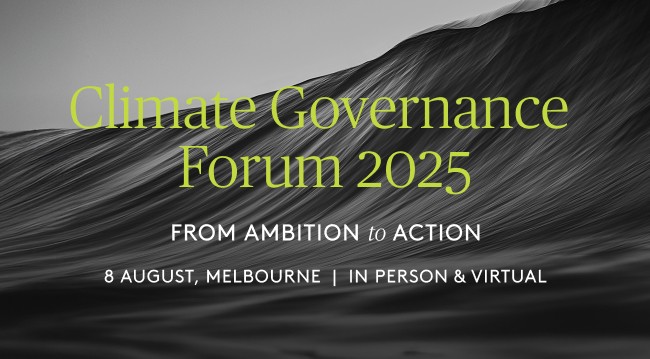In the lead-up to the Climate Governance Forum, we explore director views on decarbonisation, climate risk, and the circular economy opportunity – including insights from forum speakers Zoe Whitton and Geoff Summerhayes.
The conversation around climate governance has matured. What was once treated as a separate sustainability issue is now becoming deeply embedded in core business strategy and risk management.
Yet organisations continue to grapple with fundamental challenges: developing compelling business cases for decarbonisation investment, navigating stakeholder expectations during a volatile transition, and translating commitments into practical action.
These themes – ranging from the integration of climate strategy to the practicalities of circularity – will be front and centre at the AICD's 2025 Climate Governance Forum in August.
Making the business case for decarbonisation
For boards seeking to justify climate investments, the business case has become non-negotiable. As Zoe Whitton, Managing Director at Pollination and a board member of the Net Zero Economy Authority explains, 'There's only so far that a high-level commitment will take you.' Three factors make a business case essential.
First is spending reality. Boards are deploying significant capital on climate initiatives, and without robust business cases, these investments become vulnerable to shifting priorities. Second is organisational engagement. Climate transition requires implementation across the entire organisation. Third is strategic resilience. In a rapidly changing environment where transition policies remain volatile, business cases provide the foundation for weathering uncertainty. 'For a plan to be resilient, it really has to have a business case backing it up,' she says.
Navigating a bumpy transition
The transition to a low-carbon economy is far from smooth. Geoff Summerhayes GAICD, Chair at Zurich Financial Services Australia and of the AICD's Climate Governance Initiative Australia advisory council, describes current conditions as a recalibration period where 'ambition is being wound back for a whole pile of regulatory, legal, and broader policy stakeholder reasons.'
He observes this has created defensive positioning among some organisations, with companies becoming more risk-averse and focusing on compliance rather than opportunities. Examples include concerns about greenwashing cases and 'greenhushing' – organisations deliberately downplaying climate commitments to avoid scrutiny.
However, this recalibration should be understood as temporary. 'The direction of travel is very clear: we need to decarbonise,' Summerhayes emphasises. 'The current recalibration is just a bump on an otherwise downward trajectory.'
For boards, this means maintaining a long-term perspective while acknowledging current constraints around keeping decarbonisation goals alive internally.
From risk to risk-and-opportunity
One significant shift in climate governance is the evolution from ‘pure’ risk management to integrated risk-and-opportunity thinking. Summerhayes identifies this as a key marker of embedded climate governance: when risk and opportunity are 'integrated into board discussions, planning, capital management, and strategy.'
This balanced approach is important because, as Whitton notes, 'if climate change and transition is changing your environment, it is going to produce opportunities.' She sees too many organisations approaching climate primarily from a downside perspective, missing the strategic value of opportunity identification.
Practical implementation: Lessons from industry
In a recent AICD webinar, Barry Irvin AM GAICD, Executive Chairman of Bega Group, shared how traditional manufacturing can embrace collaboration and circularity as core elements of climate strategy. Circularity involves designing out waste and pollution and keeping materials in use for as long as possible, which is a shift from the traditional linear model of take, make and dispose.
Bega has restructured its board committees, splitting Risk and Audit and establishing a dedicated Sustainability and Risk Committee. 'We completely relaunched and repurposed our sustainability program,' Irvin explains. ‘We recognised early that to reach targets like net zero by 2050 we need to embrace circularity along without other initiatives.'
The company's approach extends beyond internal changes. The Bega Valley's National Circularity Centre, funded by the NSW Government and Bega Group, brings together stakeholders from dairy to fisheries to drive innovation in reducing waste and emissions. Irvin challenges traditional competitive thinking: 'I believe collaboration generally creates more wealth. Often my competitors are also my biggest customers.'
This collaborative circularity supports Bega's longer-term view. Rather than relying on consumers to pay a premium for sustainable products, the strategy focuses on 'designing waste out' – eliminating waste at the design stage by rethinking products, processes, and systems.
'If I invest in a new factory, it'll last 30 to 50 years. We're a 125-year-old company, and I want us to be here for another 125 years. I need to constantly respond to my future customer, not just my current customer.'
However, implementation brings specific challenges particularly regulatory ones: 'Once something is classified as waste, it often can't be reused.' Government support needs to extend beyond funding to removing regulatory roadblocks.
Moving forward
The business case for decarbonisation investment is increasingly seen as fundamental to organisational resilience in the net zero transition. But building these cases requires embracing a wide spectrum of risks and opportunities. Boards that embed climate into core governance, maintain open stakeholder dialogue, and focus on practical implementation will be better positioned for long-term value creation.
Links and further resources:
- The AICD recently held a webinar on the circular economy, complementing a director resource released in partnership with Accenture Australia to support boards in exploring circular economy opportunities.
- Next month, the AICD with ACSI will release guidance on climate transition planning, based on leading market practice.
Latest news
Already a member?
Login to view this content



